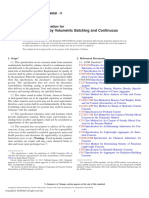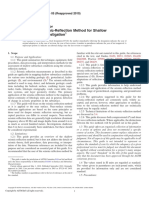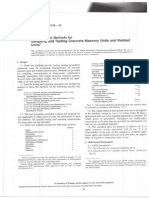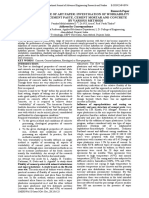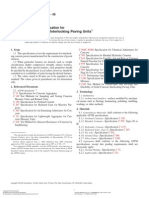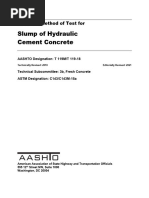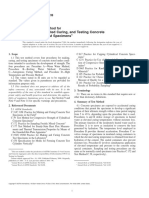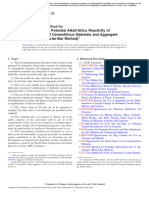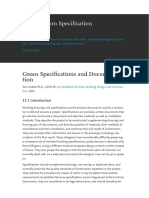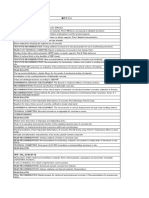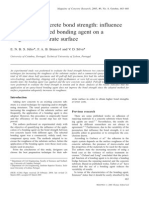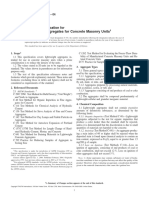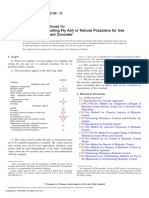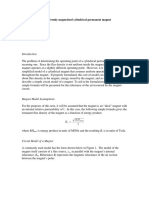Lightweight Aggregates For Concrete Masonry Units
Lightweight Aggregates For Concrete Masonry Units
Uploaded by
mickyfelixCopyright:
Available Formats
Lightweight Aggregates For Concrete Masonry Units
Lightweight Aggregates For Concrete Masonry Units
Uploaded by
mickyfelixOriginal Title
Copyright
Available Formats
Share this document
Did you find this document useful?
Is this content inappropriate?
Copyright:
Available Formats
Lightweight Aggregates For Concrete Masonry Units
Lightweight Aggregates For Concrete Masonry Units
Uploaded by
mickyfelixCopyright:
Available Formats
Designation: C331/C331M − 14
Standard Specification for
Lightweight Aggregates for Concrete Masonry Units1
This standard is issued under the fixed designation C331/C331M; the number immediately following the designation indicates the year
of original adoption or, in the case of revision, the year of last revision. A number in parentheses indicates the year of last reapproval.
A superscript epsilon (´) indicates an editorial change since the last revision or reapproval.
1. Scope* C157/C157M Test Method for Length Change of Hardened
1.1 This specification covers lightweight aggregates in- Hydraulic-Cement Mortar and Concrete
tended for use in concrete masonry units when a prime C641 Test Method for Iron Staining Materials in Light-
consideration is to reduce the density of the units. weight Concrete Aggregates
C702 Practice for Reducing Samples of Aggregate to Testing
1.2 The values stated in either SI units or inch-pound units Size
are to be regarded separately as standard. The values stated in C1262 Test Method for Evaluating the Freeze-Thaw Dura-
each system may not be exact equivalents; therefore, each bility of Dry-Cast Segmental Retaining Wall Units and
system shall be used independently of the other. Combining Related Concrete Units
values from the two systems may result in non-conformance D75 Practice for Sampling Aggregates
with the standard. Some values have only SI units because the E11 Specification for Woven Wire Test Sieve Cloth and Test
inch-pound equivalents are not used in practice. Sieves
NOTE 1—Sieve size is identified by its standard designation in Speci-
fication E11. The alternative designation given in parentheses is for 3. Aggregate Types
information only and does not represent a different standard sieve size.
3.1 Three general types of lightweight aggregates are cov-
1.3 The text of this specification references notes and
ered by this specification, as follows:
footnotes which provide explanatory material. These notes and
3.1.1 Aggregates prepared by expanding, pelletizing, or
footnotes (excluding those in tables and figures) shall not be
sintering products such as blast-furnace slag, clay, diatomite,
considered as requirements of the standard.
fly ash, shale, or slate, and
3.1.2 Aggregates prepared by processing natural materials,
2. Referenced Documents
such as pumice, scoria, or tuff, and
2.1 ASTM Standards:2 3.1.3 Aggregates consisting of end products of coal or coke
C29/C29M Test Method for Bulk Density (“Unit Weight”) combustion.
and Voids in Aggregate
3.2 The aggregates shall be composed predominately of
C40 Test Method for Organic Impurities in Fine Aggregates
lightweight-cellular and granular inorganic material.
for Concrete
C114 Test Methods for Chemical Analysis of Hydraulic 4. Chemical Composition
Cement 4.1 Lightweight aggregates shall not contain excessive
C136 Test Method for Sieve Analysis of Fine and Coarse amounts of deleterious substances, as determined by the
Aggregates following limits:
C142 Test Method for Clay Lumps and Friable Particles in 4.1.1 Organic Impurities (Test Method C40)—Lightweight
Aggregates aggregates subjected to the test for organic impurities that
C151 Test Method for Autoclave Expansion of Hydraulic produce a color darker than the standard shall be rejected,
Cement unless it is demonstrated that the discoloration is due to small
quantities of materials not harmful to the concrete.
4.1.2 Staining (Test Method C641)—An aggregate produc-
1
This specification is under the jurisdiction of ASTM Committee C09 on ing a stain index of 60 or higher shall be rejected when the
Concrete and Concrete Aggregates and is the direct responsibility of Subcommittee deposited stain is found upon chemical analysis to contain an
C09.21 on Lightweight Aggregates and Concrete.
Current edition approved April 15, 2014. Published May 2014. Originally iron content, expressed as Fe2O3 equal to or greater than 1.5
approved in 1953. Last previous edition approved in 2010 as C331–10. DOI: mg/200 g of sample.
10.1520/C0331_C0331M-14.
2
4.1.3 Loss on Ignition (Test Methods C114)—Loss on igni-
For referenced ASTM standards, visit the ASTM website, www.astm.org, or
contact ASTM Customer Service at service@astm.org. For Annual Book of ASTM
tion of aggregates, consisting of end products of coal or coke
Standards volume information, refer to the standard’s Document Summary page on combustion, shall not exceed 12 %. Loss on ignition of other
the ASTM website. aggregates shall not exceed 5 %.
*A Summary of Changes section appears at the end of this standard
Copyright © ASTM International, 100 Barr Harbor Drive, PO Box C700, West Conshohocken, PA 19428-2959. United States
Copyright by ASTM Int'l (all rights reserved); 1
C331/C331M − 14
NOTE 2—Some aggregates may contain carbonates or water of hydra- not limited to the following: cement content, cement type, admixtures, and
tion that contribute to loss on ignition but may not affect the quality of the water content.
product. Therefore, when evaluating an aggregate, consideration should be
given to the material characteristics that cause the ignition loss.
5.2.3 Drying Shrinkage—Drying shrinkage of concrete
specimens prepared and tested in accordance with 8.6 shall not
5. Physical Properties exceed 0.10 %.
5.1 Lightweight aggregate under test shall meet the follow- 6. Sampling
ing requirements:
5.1.1 Clay Lumps and Friable Particles—The amount of 6.1 Sample lightweight aggregates in accordance with Prac-
clay lumps and friable particles shall not exceed 2 % by dry tice D75.
mass. 6.2 Reduce sample to test sizes in accordance with Practice
5.1.2 Grading—Aggregate grading shall be by mutual C702.
agreement between interested parties. See Appendix X1 for
aggregate grading guidance. 7. Number of Tests
5.1.3 Uniformity of Grading—To ensure reasonable unifor- 7.1 Tests on Aggregate—One representative sample is re-
mity in the gradation of successive shipments of lightweight quired for each test for organic impurities, staining, clay lumps,
aggregate, fineness modulus shall be determined on samples loss on ignition, grading, and bulk density.
taken from shipments at intervals stipulated by the purchaser. If
the fineness modulus of the aggregate in any shipment differs 7.2 Tests on Concrete Masonry Units—Three specimens are
by more than 7 % from that of the sample submitted for required for the test for popout materials.
acceptance tests, the aggregate in the shipment shall be
rejected, unless the supplier demonstrated that it will produce 8. Test Methods
concrete of the required characteristics. 8.1 Test for Popout Materials—Obtain test specimens by
5.1.4 Loose Bulk Density (Test Method C29/C29M)—The one of the following methods: (1) Whole concrete masonry
loose bulk density of lightweight aggregates shall conform to units, free of visible cracks or other structural defects; (2)
the requirements in Table 1 using a 14 L [1⁄2 ft3] measure. Portions of concrete masonry units cut from whole units and
5.1.5 Uniformity of Loose Bulk Density—The dry loose bulk having a surface area of at least 580 cm 2 [90 in.2]; (3)
density of lightweight aggregate shipments sampled and tested Specimens prepared as described in 8.6. Autoclave test speci-
shall not differ by more than 650 kg/m3 [3 lb/ft3] or 7 %, mens in accordance with Test Method C151. Visually inspect
whichever is greater, from that of the sample submitted for the autoclaved specimens for the number of popouts that have
acceptance tests, and shall not exceed the limits in Table 1. developed on the surface and report the average number of
5.2 Concrete specimens containing lightweight aggregate popouts per specimen.
under test shall meet the following requirements: 8.2 Test for Resistance to Freezing and Thawing—Test for
5.2.1 Popouts—Concrete specimens prepared and tested in resistance to freezing and thawing of manufactured concrete
accordance with 8.1 shall show no surface popouts. masonry units and related concrete units in accordance with
5.2.2 Resistance to Freezing and Thawing—When required, Test Method C1262.
the aggregate supplier shall demonstrate by test or proven field 8.3 Grading—Follow the procedures of Test Method C136
performance that the lightweight aggregate when used in except that the mass of the test sample for fine aggregate shall
manufactured concrete masonry units and related concrete be in accordance with Table 2. The test sample for coarse
units has the necessary resistance to freezing and thawing to aggregate shall consist of 2830 cm3 [0.1 ft 3] or more of the
perform satisfactorily in its intended use. material used for determination of bulk density. Mechanical
NOTE 3—Methods are available to evaluate the performance of manu- sieving of aggregate shall be for 5 min.
factured concrete masonry products made with lightweight aggregates.
For example, Test Method C1262 includes procedures for evaluating
8.4 Bulk Density (Loose) (Test Method C29/C29M)—The
manufactured concrete masonry units and related concrete units, but does aggregate shall be tested in an oven-dry condition utilizing the
not include criteria for determining compliance. Care should be used in shoveling procedure.
evaluating the results of Test Method C1262 or any other method since the
results are affected by other characteristics of the concrete mixture in
addition to the characteristics of the lightweight aggregate, including, but
TABLE 2 Mass of Sieve Test Sample for Fine Lightweight
Aggregates
TABLE 1 Maximum Bulk Density (Dry Loose) Requirements of Nominal Bulk Density (Loose)
of Aggregate Mass of Test
Lightweight Aggregates for Concrete Masonry Units Sample, g
3 3
Maximum Dry kg/m [lb/ft ]
Nominal
Loose Bulk Density 80–240 [5–15] 50
Size Designation
kg/m3 [lb/ft3] 240–400 [15–25] 100
Fine aggregate 1120 [70] 400–560 [25–35] 150
4.75 mm (No. 4) to 0 560–720 [35–45] 200
Coarse aggregate 880 [55] 720–880 [45–55] 250
9.5 to 2.36 mm (3⁄8 in. to No. 8) 880–1040 [55–65] 300
Combined fine and coarse aggregate 1040 [65] 1040–1120 [65–70] 350
Copyright by ASTM Int'l (all rights reserved); 2
C331/C331M − 14
8.5 Clay Lumps and Friable Particles in Aggregates, shall 8.6.3 Calculate the difference in length of the specimens,
be in accordance with Test Method C142. when removed from moist storage at an age of 7 days and at the
final measurement at the age of 100 days, to the nearest 0.01 %
8.6 Shrinkage of Concrete, shall be in accordance with Test of the effective gage length, and report as the drying shrinkage
Method C157/C157M, with the following exceptions: of the specimen. Report the average drying shrinkage of the
8.6.1 Prepare a concrete mix in the proportions of one part specimens tested as the drying shrinkage of the concrete.
portland cement to six parts combined aggregates, measured by
dry loose volume. Adjust the water content so as to produce a 9. Rejection
slump of 50 to 75 mm [2 to 3 in.] and thoroughly consolidate 9.1 Material that fails to conform to the requirements of this
the concrete in steel molds 50 by 50 by 285 mm [2 by 2 by 111⁄4 specification shall be subject to rejection. The reason for
in.]. The surface of the concrete shall be steel-troweled. rejection shall be reported to the producer or supplier promptly
and in writing.
8.6.2 Cure the test specimens in a moist condition for 7 days
at a temperature of 23 6 2 °C [73.5 6 3.5 °F] and a relative 10. Certification
humidity of not less than 95 %. Make the initial length 10.1 When specified in the purchase order or contract, a
measurements immediately after removal of specimens from producer’s or supplier’s certification shall be furnished to the
moist storage. Store the specimens in an atmosphere of 23 6 2 purchaser that the material was sampled and tested in accor-
°C [73.5 6 3.5 °F] and a relative humidity of 50 6 5 % for the dance with this specification and has been found to meet the
duration of the test. Make subsequent measurements at 28 and requirements. When specified in the purchase order or contract,
100 days. a report of the test results shall be furnished.
APPENDIX
(Nonmandatory Information)
X1. AGGREGATE GRADING GUIDE FOR CONCRETE MASONRY UNITS WITH LOWER DENSITIES
X1.1 Concrete masonry units with lower densities are TABLE X1.1 Suggested Total Aggregate Grading
manufactured with lightweight aggregate, with a blend of Sieve Size
Amount Retained On Each Sieve (Volume %)
lightweight aggregates, or a blend of lightweight and normal- (see Fig. X1.1 and A )
weight aggregates. Because the aggregates being blended may 9.5 mm (3⁄8 in.) 0-2
4.75 mm (No. 4) 0-10
come from several different sources, the proper combined 2.36 mm (No. 8) 15-35
aggregate grading (see Fig. X1.1 and Table X1.1) is important, 1.18 mm (No. 16) 15-35
and is one of the essential ingredients in producing quality 600 µm (No. 30) 5-20
300 µm (No. 50) 5-15
concrete masonry units. The combined aggregate grading 150 µm (No. 100) 5-15
range shown optimizes the particle size distribution which, in Pan 8-20
A
Volume % and mass % retained on each sieve are essentially equal when the
particle density of the retained fractions are approximately the same. Volumetric
analysis of particle sizes of blended aggregates composed of aggregates of
different densities is accomplished by considering the proportions of each
aggregate.
turn, optimizes the quality of the CMU in the following ways:
X1.1.1 Compactibility and high strengths are obtained with-
out excessive amounts of cementitious materials.
X1.1.2 Shrinkage is reduced by maximizing aggregate
packing.
X1.1.3 Water absorption and penetration are reduced be-
cause of improved compaction.
X1.1.4 Resistance to freezing and thawing is improved
because better compaction results in fewer interconnected
voids.
X1.2 Comments
X1.2.1 Keep particles retained on the 9.5 mm (3⁄8 in.) sieve
to a minimum. (“0” is optimum.) (Refer to Letter “A” in Fig.
FIG. X1.1 Suggested Total Aggregate Grading X1.1.)
Copyright by ASTM Int'l (all rights reserved); 3
C331/C331M − 14
X1.2.2 A uniform, fine textured surface is controlled by
limiting the material on 4.75 mm (No. 4) and 2.36 mm (No. 8)
sieves. (Refer to Letter “B” in Fig. X1.1.)
X1.2.3 A minimum of 8 % passing the 150 µm (No. 100)
sieve is desirable for green strength, moldability and compac-
tion. Less than 8 % is acceptable when using mixtures with
high cementitious material content. (Refer to Letter “C” in Fig.
X1.1.)
SUMMARY OF CHANGES
Committee C09 has identified the location of selected changes to this specification since the last issue,
C331–10, which may impact the use of this specification. (Approved April 15, 2014)
(1) Revised Section 8.2.
ASTM International takes no position respecting the validity of any patent rights asserted in connection with any item mentioned
in this standard. Users of this standard are expressly advised that determination of the validity of any such patent rights, and the risk
of infringement of such rights, are entirely their own responsibility.
This standard is subject to revision at any time by the responsible technical committee and must be reviewed every five years and
if not revised, either reapproved or withdrawn. Your comments are invited either for revision of this standard or for additional standards
and should be addressed to ASTM International Headquarters. Your comments will receive careful consideration at a meeting of the
responsible technical committee, which you may attend. If you feel that your comments have not received a fair hearing you should
make your views known to the ASTM Committee on Standards, at the address shown below.
This standard is copyrighted by ASTM International, 100 Barr Harbor Drive, PO Box C700, West Conshohocken, PA 19428-2959,
United States. Individual reprints (single or multiple copies) of this standard may be obtained by contacting ASTM at the above
address or at 610-832-9585 (phone), 610-832-9555 (fax), or service@astm.org (e-mail); or through the ASTM website
(www.astm.org). Permission rights to photocopy the standard may also be secured from the ASTM website (www.astm.org/
COPYRIGHT/).
Copyright by ASTM Int'l (all rights reserved); 4
You might also like
- Abrasion Resistance of Horizontal Concrete Surfaces: Standard Test Method ForDocument7 pagesAbrasion Resistance of Horizontal Concrete Surfaces: Standard Test Method FormickyfelixNo ratings yet
- Concrete Made by Volumetric Batching and Continuous Mixing: Standard Specification ForDocument9 pagesConcrete Made by Volumetric Batching and Continuous Mixing: Standard Specification Formickyfelix100% (2)
- Astm C1491Document3 pagesAstm C1491BeymerBustamanteMejíaNo ratings yet
- Using The Seismic-Reflection Method For Shallow Subsurface InvestigationDocument26 pagesUsing The Seismic-Reflection Method For Shallow Subsurface InvestigationmickyfelixNo ratings yet
- Estimating The Permanganate Natural Oxidant Demand of Soil and Aquifer SolidsDocument5 pagesEstimating The Permanganate Natural Oxidant Demand of Soil and Aquifer SolidsmickyfelixNo ratings yet
- ASTM C331-2010 Light Weight Aggregates For MasonryDocument4 pagesASTM C331-2010 Light Weight Aggregates For MasonryHaniAminNo ratings yet
- Astm C140 - 12Document16 pagesAstm C140 - 12jjaavenido100% (11)
- Determination of Pore Volume and Pore Volume Distribution of Soil and Rock by Mercury Intrusion PorosimetryDocument8 pagesDetermination of Pore Volume and Pore Volume Distribution of Soil and Rock by Mercury Intrusion PorosimetryWanucy Barroso RodriguesNo ratings yet
- ASTM-C1314-07 (2007) - Compressive Strength of Masonry PrismsDocument10 pagesASTM-C1314-07 (2007) - Compressive Strength of Masonry PrismsMohammad Raihan MukhlisNo ratings yet
- Final Report Siliceous Byproducts For Use in Concrete 1988Document12 pagesFinal Report Siliceous Byproducts For Use in Concrete 1988engenharia.skf100% (1)
- 226 PDFDocument8 pages226 PDFBatepola BacNo ratings yet
- PDF Astm c171 - CompressDocument2 pagesPDF Astm c171 - CompressNala BlackfireNo ratings yet
- Astm C109Document6 pagesAstm C109nicol pomaNo ratings yet
- Astm C145 85Document2 pagesAstm C145 85Jorge Patazca100% (1)
- ASTM C 39 Standard Test Method For Compressive Strength of Cylindrical Concrete SpecimensDocument8 pagesASTM C 39 Standard Test Method For Compressive Strength of Cylindrical Concrete SpecimensMohamed HunaisNo ratings yet
- Preformed Expansion Joint Filler For Concrete (Bituminous Type)Document2 pagesPreformed Expansion Joint Filler For Concrete (Bituminous Type)mjgutierrezperaltaNo ratings yet
- Silica Fume 5 PDFDocument14 pagesSilica Fume 5 PDFNour KottiNo ratings yet
- Astm A820 - 2011Document4 pagesAstm A820 - 2011Lissette Rohs Mauricio HerhuayNo ratings yet
- Air-Entraining Admixtures For ConcreteDocument4 pagesAir-Entraining Admixtures For ConcretemickyfelixNo ratings yet
- C652 PDFDocument7 pagesC652 PDFjadal khanNo ratings yet
- Making and Curing Concrete Test Specimens in The Laboratory: Standard Practice ForDocument8 pagesMaking and Curing Concrete Test Specimens in The Laboratory: Standard Practice ForAhmed AbidNo ratings yet
- Astm C-295Document9 pagesAstm C-295Amy100% (1)
- D3551-08 Standard Practice For Laboratory Preparation of Soil-Lime Mixtures Using Mechanical MixerDocument2 pagesD3551-08 Standard Practice For Laboratory Preparation of Soil-Lime Mixtures Using Mechanical MixerFaten Abou ShakraNo ratings yet
- Astm C33Document11 pagesAstm C33Ali ArsalanNo ratings yet
- Determination of Length Change of Concrete Due To Alkali-Silica ReactionDocument6 pagesDetermination of Length Change of Concrete Due To Alkali-Silica ReactionEvert RiveraNo ratings yet
- Density, Absorption, and Voids in Hardened Concrete: Standard Test Method ForDocument3 pagesDensity, Absorption, and Voids in Hardened Concrete: Standard Test Method ForMohamed BelmokaddemNo ratings yet
- TDS - Rheomac 707Document3 pagesTDS - Rheomac 707Alexi ALfred H. Tago100% (1)
- Astm C128 22Document4 pagesAstm C128 22Leon ZidaneNo ratings yet
- Astm C 936Document3 pagesAstm C 936vidhisukhadiya100% (1)
- Astm C1293.35962Document7 pagesAstm C1293.35962margarethsmNo ratings yet
- Silica Fume Used in Cementitious Mixtures: Standard Specification ForDocument7 pagesSilica Fume Used in Cementitious Mixtures: Standard Specification ForRahish RaviNo ratings yet
- Is549 Evaluation of Alkali Silica Reactivity (Asr) Mortar Bar Testing (Astm c1260 and c1567) at 14 Days and 28 DaysDocument4 pagesIs549 Evaluation of Alkali Silica Reactivity (Asr) Mortar Bar Testing (Astm c1260 and c1567) at 14 Days and 28 DaysSandro Mendes100% (1)
- Slag Cement For Use in Concrete and MortarsDocument7 pagesSlag Cement For Use in Concrete and MortarsCory BradleyNo ratings yet
- Evaluation of Cement Mortars by Ultrasound N.Gözde Özerkan, Đ. Özgür YamanDocument11 pagesEvaluation of Cement Mortars by Ultrasound N.Gözde Özerkan, Đ. Özgür YamanAdam PapworthNo ratings yet
- Compression Testing ASTM C 39 PDFDocument7 pagesCompression Testing ASTM C 39 PDFMoshiur RahmanNo ratings yet
- D2172D2172M 17Document10 pagesD2172D2172M 17mehdiNo ratings yet
- ASTM C494/C494M-19e1 Standard Specification For Chemical Admixtures For ConcreteDocument3 pagesASTM C494/C494M-19e1 Standard Specification For Chemical Admixtures For ConcreteSudhanNo ratings yet
- Astm C143 C143M 20Document3 pagesAstm C143 C143M 20Mohaa rabiaNo ratings yet
- ASTM C-845 Expansive Hydraulic Cement1Document3 pagesASTM C-845 Expansive Hydraulic Cement1Hsaam HsaamNo ratings yet
- C827C827M 16Document5 pagesC827C827M 16Jamman Shahid ShiblyNo ratings yet
- C637-14 Standard Specification For Aggregates For Radiation-Shielding ConcreteDocument4 pagesC637-14 Standard Specification For Aggregates For Radiation-Shielding ConcreteFahad RedaNo ratings yet
- AASHTO T119M (2018) - Slump of Hydraulic Cement ConcreteDocument8 pagesAASHTO T119M (2018) - Slump of Hydraulic Cement ConcreteErnesto Oscar VidelaNo ratings yet
- Making, Accelerated Curing, and Testing Concrete Compression Test SpecimensDocument10 pagesMaking, Accelerated Curing, and Testing Concrete Compression Test SpecimensIbrahim DanishNo ratings yet
- Flow of Freshly Mixed Hydraulic-Cement Concrete: Standard Test Method ForDocument3 pagesFlow of Freshly Mixed Hydraulic-Cement Concrete: Standard Test Method ForEvert RiveraNo ratings yet
- Flexural Toughness of Fiber Reinforced Concrete (Using Centrally Loaded Round Panel)Document13 pagesFlexural Toughness of Fiber Reinforced Concrete (Using Centrally Loaded Round Panel)AshishNo ratings yet
- C110.15543 ASTM StandardtestmethodforphysicaltestingofquicklimehydratedlimeandlimestoneDocument24 pagesC110.15543 ASTM StandardtestmethodforphysicaltestingofquicklimehydratedlimeandlimestoneCarolina Valdebenito RogaNo ratings yet
- Testing of Sand Quality at Construction Site For ConcreteDocument3 pagesTesting of Sand Quality at Construction Site For ConcreteGhanshyam Kumar PandeyNo ratings yet
- Standard Specification For Deformed and Plain Low-Alloy Steel Bars For Concrete ReinforcementDocument7 pagesStandard Specification For Deformed and Plain Low-Alloy Steel Bars For Concrete ReinforcementJose Fernando Huayhua ApfataNo ratings yet
- ASTM C 593-06 - Standard Specification For Fly Ash and Other Pozzolans For Use With LimeDocument5 pagesASTM C 593-06 - Standard Specification For Fly Ash and Other Pozzolans For Use With Limeluisenriq33100% (1)
- Determining The Potential Alkali-Silica Reactivity of Combinations of Cementitious Materials and Aggregate (Accelerated Mortar-Bar Method)Document6 pagesDetermining The Potential Alkali-Silica Reactivity of Combinations of Cementitious Materials and Aggregate (Accelerated Mortar-Bar Method)Cory BradleyNo ratings yet
- Green Building Specification-1Document43 pagesGreen Building Specification-1charNo ratings yet
- Aggregate For Masonry MortarDocument2 pagesAggregate For Masonry MortarNada Khlif100% (1)
- Chemical Admixtures For ConcreteDocument15 pagesChemical Admixtures For ConcreteKMNo ratings yet
- C 823 - 00 - QzgymwDocument7 pagesC 823 - 00 - QzgymwEstefany AcostaNo ratings yet
- BS EB 934 - 6 - 2001 Corr 13534 Oct 01Document12 pagesBS EB 934 - 6 - 2001 Corr 13534 Oct 01Abu Muhammad iftikharNo ratings yet
- 1881 5-70Document27 pages1881 5-70bhagwatpatilNo ratings yet
- Unit Weight and Voids in Aggregate: Standard Method of Test ForDocument4 pagesUnit Weight and Voids in Aggregate: Standard Method of Test ForEvert RiveraNo ratings yet
- Astm D6938 NuclearDocument3 pagesAstm D6938 NuclearRey Rapay100% (1)
- BS en 679-2005Document10 pagesBS en 679-2005adhi ym100% (1)
- C1611C1611M 14371Document6 pagesC1611C1611M 14371josueNo ratings yet
- RilemDocument78 pagesRilemسارة المالكيNo ratings yet
- Astm D7226 (Viscosidad Dinámica Por Paletas)Document4 pagesAstm D7226 (Viscosidad Dinámica Por Paletas)Santiago Molina Huertas100% (2)
- Concrete Bond StrengthDocument6 pagesConcrete Bond Strengthharikrishna007No ratings yet
- C 331 - 04 - QZMZMQ - PDFDocument4 pagesC 331 - 04 - QZMZMQ - PDFRobert ThompsonNo ratings yet
- Coal Fly Ash and Raw or Calcined Natural Pozzolan For Use in ConcreteDocument5 pagesCoal Fly Ash and Raw or Calcined Natural Pozzolan For Use in ConcretemickyfelixNo ratings yet
- D 7046Document8 pagesD 7046mickyfelixNo ratings yet
- Developing Appropriate Statistical Approaches For Groundwater Detection Monitoring ProgramsDocument15 pagesDeveloping Appropriate Statistical Approaches For Groundwater Detection Monitoring ProgramsmickyfelixNo ratings yet
- Latex Agents For Bonding Fresh To Hardened ConcreteDocument2 pagesLatex Agents For Bonding Fresh To Hardened ConcretemickyfelixNo ratings yet
- Chemical Admixtures For Use in Producing Flowing ConcreteDocument9 pagesChemical Admixtures For Use in Producing Flowing Concretemickyfelix100% (1)
- In-Place Density of Unhardened and Hardened Concrete, Including Roller Compacted Concrete, by Nuclear MethodsDocument5 pagesIn-Place Density of Unhardened and Hardened Concrete, Including Roller Compacted Concrete, by Nuclear MethodsmickyfelixNo ratings yet
- Fiber-Reinforced Concrete: Standard Specification ForDocument7 pagesFiber-Reinforced Concrete: Standard Specification FormickyfelixNo ratings yet
- Determining Density of Structural Lightweight Concrete: Standard Test Method ForDocument4 pagesDetermining Density of Structural Lightweight Concrete: Standard Test Method FormickyfelixNo ratings yet
- Total Evaporable Moisture Content of Aggregate by Drying: Standard Test Method ForDocument3 pagesTotal Evaporable Moisture Content of Aggregate by Drying: Standard Test Method FormickyfelixNo ratings yet
- Splitting Tensile Strength of Cylindrical Concrete SpecimensDocument5 pagesSplitting Tensile Strength of Cylindrical Concrete SpecimensmickyfelixNo ratings yet
- Lightweight Aggregates For Structural ConcreteDocument4 pagesLightweight Aggregates For Structural ConcretemickyfelixNo ratings yet
- Lightweight Aggregates For Insulating ConcreteDocument3 pagesLightweight Aggregates For Insulating ConcretemickyfelixNo ratings yet
- Sampling and Testing Fly Ash or Natural Pozzolans For Use in Portland-Cement ConcreteDocument10 pagesSampling and Testing Fly Ash or Natural Pozzolans For Use in Portland-Cement ConcretemickyfelixNo ratings yet
- Packaged, Dry, Combined Materials For Concrete and High Strength MortarDocument5 pagesPackaged, Dry, Combined Materials For Concrete and High Strength MortarmickyfelixNo ratings yet
- Field Pneumatic Slug (Instantaneous Change in Head) Tests To Determine Hydraulic Properties of Aquifers With Direct Push Groundwater SamplersDocument15 pagesField Pneumatic Slug (Instantaneous Change in Head) Tests To Determine Hydraulic Properties of Aquifers With Direct Push Groundwater SamplersmickyfelixNo ratings yet
- Determination of Temporary Ditch Check Performance in Protecting Earthen Channels From Stormwater-Induced ErosionDocument8 pagesDetermination of Temporary Ditch Check Performance in Protecting Earthen Channels From Stormwater-Induced ErosionmickyfelixNo ratings yet
- Consolidated Drained Triaxial Compression Test For SoilsDocument11 pagesConsolidated Drained Triaxial Compression Test For SoilsmickyfelixNo ratings yet
- Air-Entraining Admixtures For ConcreteDocument4 pagesAir-Entraining Admixtures For ConcretemickyfelixNo ratings yet
- Measuring Deflections Using A Portable Impulse Plate Load Test DeviceDocument5 pagesMeasuring Deflections Using A Portable Impulse Plate Load Test Devicemickyfelix100% (1)
- Astm C 215Document7 pagesAstm C 215mickyfelixNo ratings yet
- Preformed Polychloroprene Elastomeric Joint Seals For BridgesDocument4 pagesPreformed Polychloroprene Elastomeric Joint Seals For BridgesmickyfelixNo ratings yet
- Highway Traffic Monitoring Truth-in-Data: Standard Practice ForDocument5 pagesHighway Traffic Monitoring Truth-in-Data: Standard Practice FormickyfelixNo ratings yet
- 02 Dynamic Modelling For Vapour Compression Systems - RasmussenDocument19 pages02 Dynamic Modelling For Vapour Compression Systems - RasmussenAllyson LuizNo ratings yet
- Foaming Ability of Soaps and DetergentsDocument13 pagesFoaming Ability of Soaps and DetergentsSanjukta Cyrus60% (5)
- Sludge BulkingDocument24 pagesSludge BulkingEdo Fransiskus Aritonang100% (1)
- Kansas FlyerDocument4 pagesKansas FlyerRicardo VelozNo ratings yet
- Safety Data Sheet Winsor & Newton Water Colour Granulation Medium (Us MSDS)Document4 pagesSafety Data Sheet Winsor & Newton Water Colour Granulation Medium (Us MSDS)Bull433No ratings yet
- Resistivity Hight EvaluationDocument13 pagesResistivity Hight EvaluationsriiwullanNo ratings yet
- JEE Main Sample Question Paper 7Document29 pagesJEE Main Sample Question Paper 7Tanvir ShafalNo ratings yet
- CertificateDocument28 pagesCertificateKhaldi KaisNo ratings yet
- Short-Pulse Laser-Plasma Interactions PDFDocument25 pagesShort-Pulse Laser-Plasma Interactions PDFAjit UpadhyayNo ratings yet
- Science6 1 Quarter Practice Test Fill in The Blanks:: DecantationDocument4 pagesScience6 1 Quarter Practice Test Fill in The Blanks:: DecantationPinky Laysa100% (2)
- CM8 - CONS 1 - EnglishDocument14 pagesCM8 - CONS 1 - EnglishAndres Felipe Angulo RoaNo ratings yet
- Bar MagnetDocument8 pagesBar Magnetjames<XIIINo ratings yet
- Physics AruldhasDocument11 pagesPhysics AruldhasArun0% (1)
- Class 12 Chemistry Syllabus 2023-24Document3 pagesClass 12 Chemistry Syllabus 2023-24Rooh KSHIVNo ratings yet
- Rangolite C MSDSDocument6 pagesRangolite C MSDSTayyab AwanNo ratings yet
- Difference Between Atom and Molecule (With Comparison Chart) - Key DifferencesDocument5 pagesDifference Between Atom and Molecule (With Comparison Chart) - Key Differencestarak dasNo ratings yet
- Data Discovery StudioDocument15 pagesData Discovery Studioazzatul amiraNo ratings yet
- Linx Refresher Sept 2012 IPD PPD Without AnswersDocument7 pagesLinx Refresher Sept 2012 IPD PPD Without AnswersDeyn EstoqueNo ratings yet
- SD13097 - Silcor Primer BS - (KOR)Document11 pagesSD13097 - Silcor Primer BS - (KOR)nlmiNo ratings yet
- Ocean Drilling Program Wireline Logging Manual V2 Ch1 Scientific Well LoggingDocument7 pagesOcean Drilling Program Wireline Logging Manual V2 Ch1 Scientific Well LoggingMarwan SalamahNo ratings yet
- Q1 - SCIENCE 7 - Summative Test 2 (W4&5) - 2021-2022Document2 pagesQ1 - SCIENCE 7 - Summative Test 2 (W4&5) - 2021-2022Malixi Integrated School (CARAGA - Surigao del Sur)No ratings yet
- 06 Geo110 Atmospheric Moisture Weather Compressed PDFDocument92 pages06 Geo110 Atmospheric Moisture Weather Compressed PDFhammad munirNo ratings yet
- Parr - A2000G - High Pressure Electrolyzer Cell - Sales LiteratureDocument1 pageParr - A2000G - High Pressure Electrolyzer Cell - Sales LiteratureAravind KandaswamiNo ratings yet
- MẪU ĐỀ THI B1!1!2022-Đáp Án - DoneDocument6 pagesMẪU ĐỀ THI B1!1!2022-Đáp Án - DoneBộ môn Ngoại ngữNo ratings yet
- Lattice Oxygen Activation and Local Electric Field Enhancement by Co-Doping Fe and F in CoO Nanoneedle Arrays For Industrial Electrocatalytic Water OxidationDocument12 pagesLattice Oxygen Activation and Local Electric Field Enhancement by Co-Doping Fe and F in CoO Nanoneedle Arrays For Industrial Electrocatalytic Water Oxidationhusongyao2233No ratings yet
- Transwell Permeable Supports: Including Snapwell and Netwell InsertsDocument8 pagesTranswell Permeable Supports: Including Snapwell and Netwell InsertsPili CárdenasNo ratings yet
- Pharmacopore JouranalDocument7 pagesPharmacopore JouranalvenaNo ratings yet
- Astronomy Thesis StatementDocument4 pagesAstronomy Thesis Statementdawnjonesbaltimore100% (1)
- Solvant Issue PermitDocument2 pagesSolvant Issue PermitSafety KingNo ratings yet
- Solving A Mystery of Nadi Astrology PDFDocument6 pagesSolving A Mystery of Nadi Astrology PDFshubham nannawareNo ratings yet

